Who does not love pretty purple flowers? In a proper spot, purple flowers can add a charming touch to the aesthetics of a lawn. However, these purple flowering plants can sometimes overgrow and quickly take over the entire lawn. While most weeds are insufferable on their own and keeping a weed-free lawn is hard, purple flower weeds are especially aggressive. Dealing with weeds with purple flowers can be physically, mentally, and financially challenging.
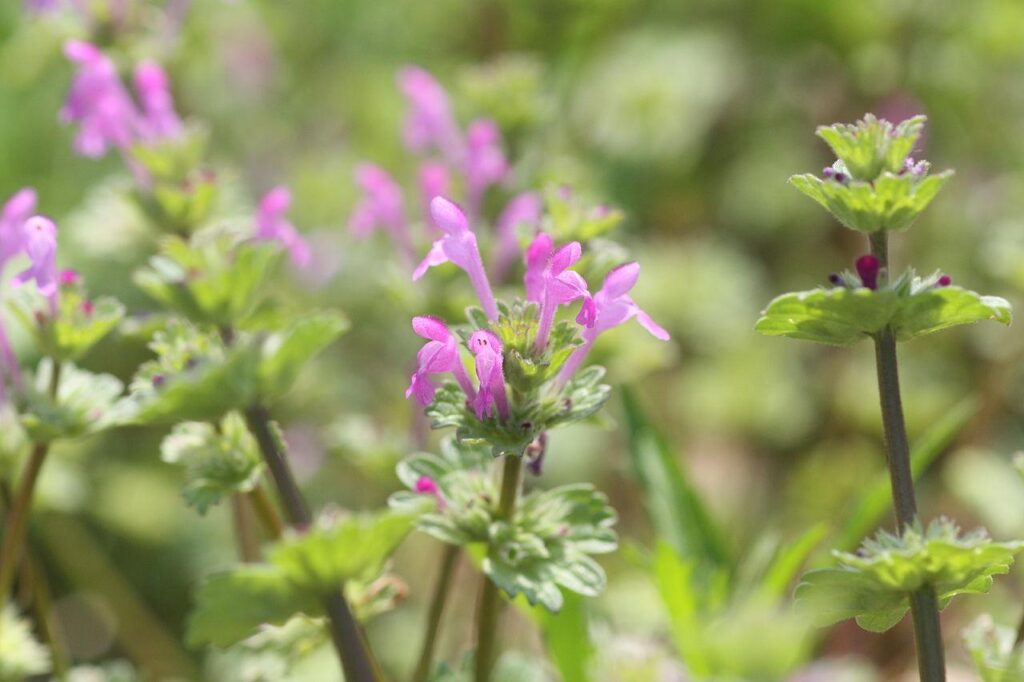
Purple flowering weeds look pretty, but they can quickly become a nuisance if left alone to bloom freely in your lawn.
To complicate matters even more, there are many purple-flowered weeds. To get rid of these pesky plants, you will first have to identify the species you are dealing with in order to create a control strategy. So, whether you are a lawn owner dealing with a pesky weed with purple flowers or merely a curious individual trying to identify weeds, we have got you covered!
In this article, you will learn how to identify lawn weeds with purple flowers and what you can do to get rid of them. However, it would help if you kept in mind that you should not immediately remove every purple flower weed that you come across. Some purple-flowered garden weeds have culinary and medicinal uses, while others attract beneficial pollinating insects, So some of them might be worth keeping around.
And by the end of this article, you will have learned when and how these common weeds present themselves, what you can do to get rid of them and which purple flowering weeds you should keep around. Happy reading!
Related: 65 Stunning Purple Flowers of Different Types (Including Pictures)
Common Weeds With Purple Flowers
1. Wild Violets
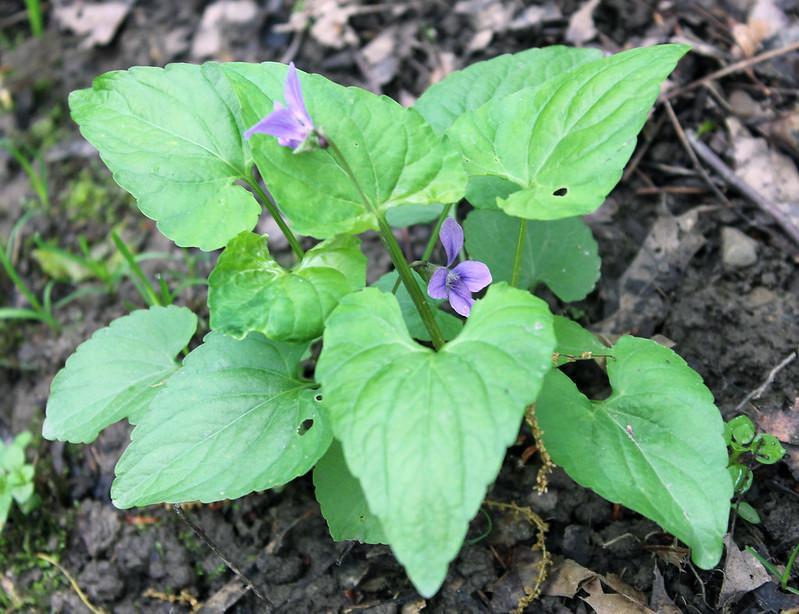
Wild violet is a state flower of many states in the United States.
As surprising as it is, wild violets do have the potential to transform into fast-spreading weeds. Depending on the species, a wild violet plant may behave differently from others. However, one common trait that each wild violet species shares is the ability to propagate from underground stems called rhizomes.
Like other weeds, they can rob other plants of nutrients, sunlight, and space in your garden. Wild violets prefer moist soil and shady areas; however, mature plants are somewhat drought tolerant. This means that wild violets can emerge under a tree but then spread to nearly every part of the lawn.
To get rid of weedy wild violets in your lawn, you can try uprooting them from the ground during the early stage of an infestation. However, make sure that you remove the underneath rhizomes entirely, or the weed will regrow. Moreover, once wild violets have taken hold of your lawn, you can also try using a herbicide.
Wild Violet Quick Facts
| Scientific name | Viola sororia |
| Other names | Common meadow violet, purple violet, hooded violet, blue-violet, wood violet |
| Weed type | Short-stemmed herbaceous perennial weed |
| Height | 15 to 25 cm tall on average |
| Flowering & leaves | – Plant shows purple blooms from April to August – Flowers have white throats, and the lower three petals are somewhat hairy – Plant has heart-shaped green leaves |
| Habitat and Distribution | – Distributed widely in Eastern United States, Canada, and parts of Mexico- Habitats include moist nutrient-rich soil such as swamps and woods |
2. Purple Dead Nettle
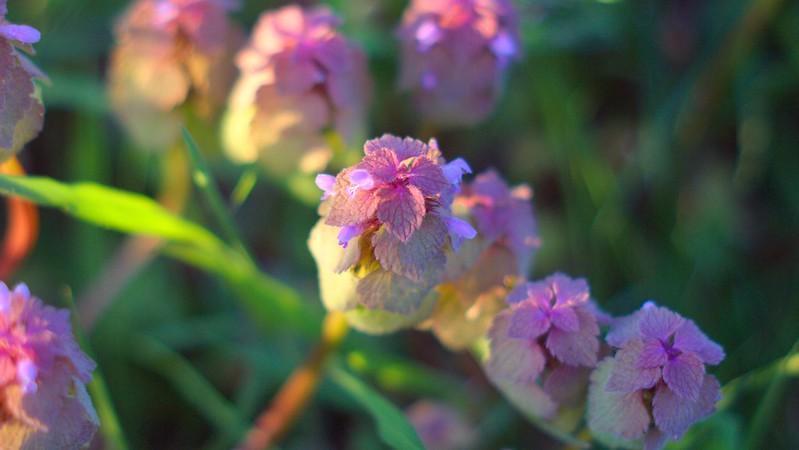
Purple deadnettle plants are common weeds in the United States, Canada, and the British Isles.
Purple dead nettle or purple deadnettle is a member of the mint family. It is an exceptionally hardy weed, and it can resist pests, disease, and harsh terrain conditions. Purple dead nettle is often confused with henbit, which has stemless leaves. Purple dead nettle plants have a characteristic square-shaped stem. Purple deadnettle is an annual winter weed. Some plants might also produce pink and white flowers in addition to purple flowers.
Purple deadnettle begins to develop in fall and completes its development in spring. Then, it dies in early spring or early summer after seed production. Gardeners keep purple deadnettle plants around as they attract bees and other pollinators. However, it can quickly take over entire garden beds if not taken care of in time.
Purple Dead Nettle Quick Facts
| Scientific name | Lamium purpureum |
| Other names | Red dead-nettle, purple archangel |
| Weed type | Annual herbaceous flowering weed |
| Height | 5 to 20 cm tall on average |
| Flowering & leaves | – Red-purple flowers might be produced all year round – Flowers have a hood-like top petal and two lower lip petals – Leaves are crowded heart-shaped |
| Habitat and Distribution | – Native to Europe and Asia – A common lawn weed in the United States, Canada, and the British Isles- Habitat includes moist areas such as meadows, forest edges, and gardens |
3. Ground Ivy
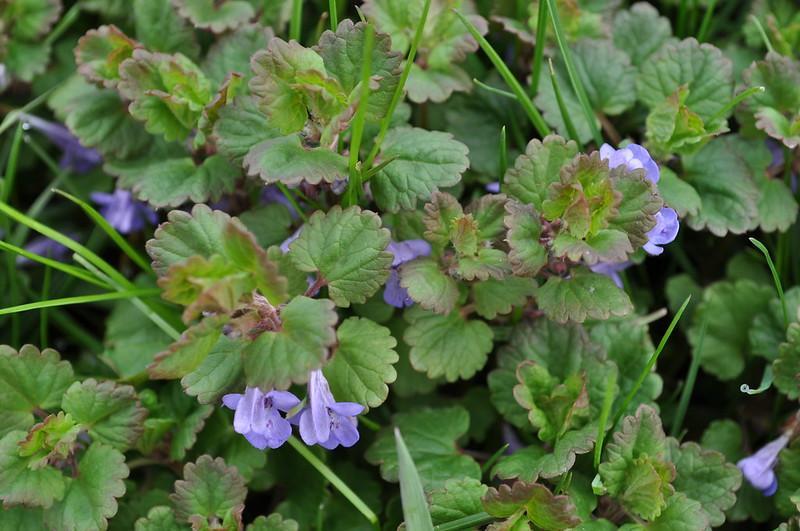
Ground ivy is used in salads in many countries.
Ground ivy is another weed with purple flowers that belongs to the mint family. It is a broadleaf weed that often makes professional gardeners or lawn owners scream. These weeds rob existing plants of space, nutrients, and water. In some parts of the United States, it is regarded as the most challenging and common lawn weed. Ground ivy spreads via creeping stems, seeds, and underground rhizomes.
Since ground ivy plants have an extensive root system, pulling out an entire plant can be difficult. Also, it tends to come back unless all parts of the plant and weed roots are removed. Therefore, these broadleaf weeds are best dealt with broadleaf herbicides. Also, improving turf grass conditions such as water drainage, fertility and shade will allow your lawn to compete better against ground ivy.
Ground Ivy Quick Facts
| Scientific name | Glechoma hederacea |
| Other names | Creeping charlie, alehoof, tunhoof, gill-over-the-ground, catsfoot, field balm, creeping jenny, run-away-robin |
| Weed type | Aromatic perennial bloomer |
| Height | Depending on environmental conditions, the plant maybe 5 to 50 cm tall |
| Flowering & leaves | – Flowering occurs during early spring to late spring – Pretty purple flowers with a funnel shape that grow in clusters – Leaves are lobed, round, and attached to the stem in the center |
| Habitat and Distribution | – Native to Eurasia- Widely distributed throughout most of North America and north of Mexico – Most common habitats include drainage ditches, swamps, waste grounds, damps, disturbed areas, pastures, forest edges, etc. |
4. Canada Thistle

Canada thistle is used in tonics to soothe stomach cramps and vomiting.
These perennial weeds grow very aggressively and continue to produce new shoot systems through their shallow roots. It is very difficult to control, and other plants in the area often have difficulty competing against this perennial weed. The common weed also affects cattle negatively.
Due to its aggressive growth, it tends to make monocultures, out-competing native plants and reducing biodiversity. Therefore, a sound management plan is needed to prevent weeds of this kind from taking over. Hand pulling is usually not effective as these weeds can quickly grow back from their extensive root system.
The best way to get rid of these nasty weeds is to stress them out and force them to use stored nutrients.
Canada Thistle Quick Facts
| Scientific name | Cirsium arvense |
| Other names | Creeping thistle, field thistle, cursed thistle, hard thistle, prickly thistle, way thistle, stinger-needles, small-flowered thistle |
| Weed type | Creeping herbaceous perennial weed |
| Height | 2 to 5 feet tall on average |
| Flowering & leaves | – Flowers bloom from June to September – Flowers appear pink with a purplish hue – Flowers develop in clusters at the end of the stem – Leaves have deep lobes and are lance-shaped |
| Habitat and Distribution | – Native to Europe, western Asia, and northern Africa – Introduced elsewhere, common in southern and northwestern states of the US- Habitats include sunny disturbed areas like roadsides, hayfields, and ditches |
5. Henbit Deadnettle
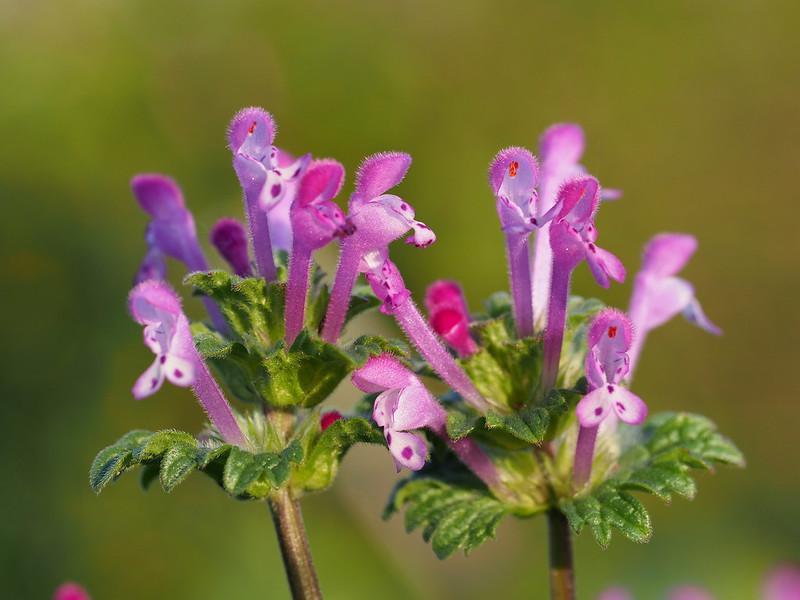
Henbit deadnettle is especially adored by hens giving this weed its common name
Henbit deadnettle is another weed with purple flowers that often becomes a nuisance for lawn owners and gardeners. These weeds are sparsely hairy and have delicate stems that branch at the base. Henbit deadnettle is often confused with purple deadnettle. However, the purple deadnettle has distinct triangular upper leaves.
The weed often shows up uninvited in lawns and has prolific seed production. The best way to prevent these weeds from taking control of a lawn is to remove them before they start producing seeds. Seeds sometimes even remain viable five years after production. Hand pulling is effective when the plant is young; however, you can use a pre-emergent herbicide to do the job once the plant is mature.
Henbit deadnettle Quick Facts
| Scientific name | Lamium amplexicaule |
| Other names | Greater henbit, common henbit |
| Weed type | Low-growing annual plant |
| Height | Height is around 40 cm on average |
| Flowering & leaves | – Flowers bloom in early spring in northern areas – In warmer locations, flowers bloom through most of the winter – Leaves are heart-shaped and have rounded teeth – Upper leaves are sessile and have deep lobes |
| Habitat and Distribution | – Native to Europe, Asia, and northern Africa – Introduced and found across most of North America – Its habitats include cool, moist areas such as turf grass, parks, pastures, etc. |
6. Forget-Me-Nots
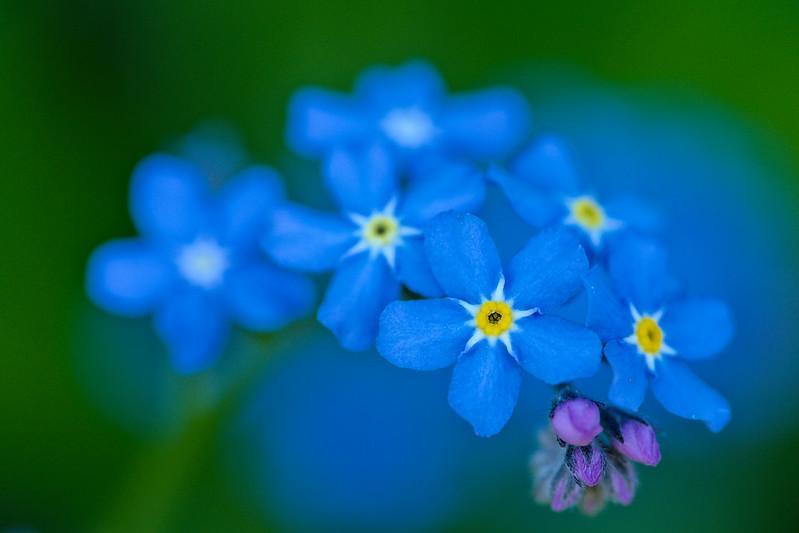
Forget-me-not is the official flower of Sweden.
Forget-Me-Nots are known to produce purple or white flowers with a yellow center. These weeds grow in full sun to partial shade in organically rich and consistently moist, well-drained soils. These weeds are often favored for border planting as they look pretty and are easy to care for. However, if not controlled, these plants can grow very aggressively. Forget-me-not is listed as a noxious weed in many Midwestern states.
The best strategy for preventing these weeds from taking hold of your garden is to prevent their seeds from taking roots. Hand pulling can be effective for small plants like many weeds, but for an already established infestation of forget-me-nots, you might need some sort of herbicide.
Forget-Me-Nots Quick Facts
| Scientific name | Myosotis sylvatica |
| Other names | Woodland forget-me-not, wood forget-me-not |
| Weed type | Short-lived herbaceous perennial plant |
| Height | 15 to 20 cm tall on average |
| Flowering & leaves | – Flowers are purple or sky-blue – Flowers bloom between April and July – Leaves are basal, alternate, and stalked |
| Habitat and Distribution | – Official flower of Sweden, Alaska, and Dalsland – Grow best in moist places such as moist woodlands, riverbanks, marshes, ponds, etc. |
7. Common Thistle
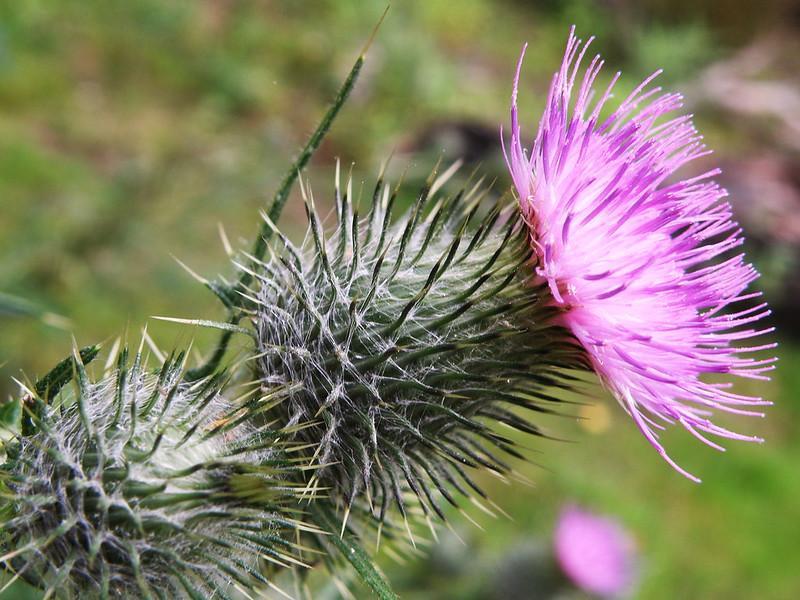
Common thistle leaves are used in tea to relieve stomach cramps and nausea.
It is not hard to identify a common thistle plant. They can be easily recognized by fluffy purple flowers which sit atop a spiky ball. These plants can quickly invade any type of disturbed area. Once established, these weeds form dense thickets and eventually carry out other native vegetation. Common thistle is declared invasive in many states of the United States.
It is important to note that common thistles can attack many types of butterflies. However, they grow very aggressively when conditions are favorable, so it is better to get rid of them or keep their numbers in check. Also, mowing the lawn as much as possible can help you prevent these weeds from spreading.
Common Thistle Quick Facts
| Scientific name | Cirsium vulgare |
| Other names | Bull thistle, spear thistle |
| Weed type | Biennial monocarpic thistle |
| Height | 3 to 10 feet tall on average |
| Flowering & leaves | – Flowers appear from June to October- Each flower head contains numerous disc florets- Leaves are lobes and have small hair and scattered spines |
| Habitat and Distribution | – Native to Europe- Widespread in many regions of the world, including the United States- Habitats include pastures, field edges, and roadsides |
8. Musk Thistle

Musk thistle grows at elevations of around 2500 meters.
These plants are incredibly prolific seed producers. A single plant can produce as many as 120,000 seeds in its lifetime. In addition, these hardy seeds can stay dormant for long periods, germinating when moisture and light conditions become favorable.
These thistle plants are designated as noxious weeds, and prevention is the best control strategy for these pesky weeds. Having well-established forbs and perennial grasses can help you prevent them from taking root in your garden.
Musk Thistle Quick Facts
| Scientific name | Carduus nutans |
| Other names | Nodding thistle, nodding plumeless thistle |
| Weed type | Biennial herbaceous weed |
| Height | Up to 6 feet tall |
| Flowering & leaves | – Flowers bloom from late spring to late summer – Flowers grow in the form of globose heads – Leaves are pinnately lobed and have sharp yellow-whitish spines |
| Habitat and Distribution | – Native to Europe and Asia – Gross at higher elevations in neutral to acidic soils |
9. Dove’s-Foot Crane’s-Bill
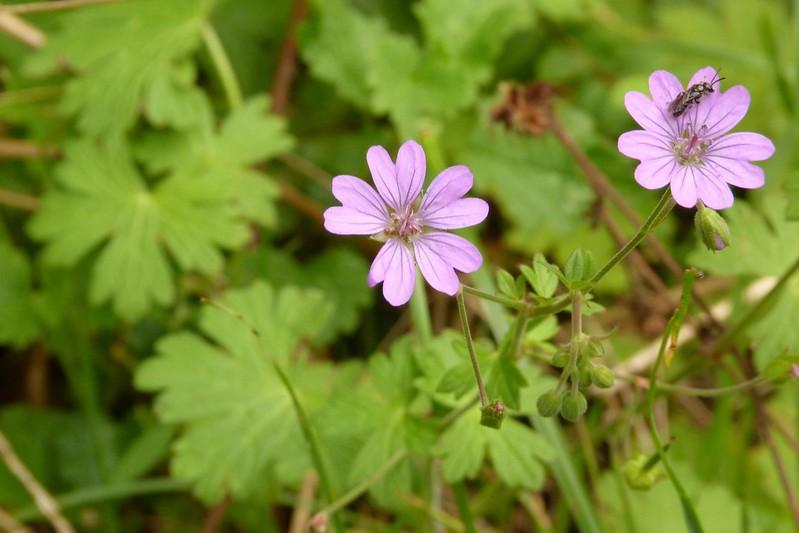
Dove’s-Foot Crane’s-Bill purple flowers.
Dove’s-Foot Crane’s-Bill is a common weed of poorly growing lawns. The plant reproduces with the help of explosive seed pods, which can spread seeds over a wide area.
The best way to control these weeds is to mow low and often. Raking the lawn before cutting the grass and picking up any seed heads can also help prevent these weeds from growing.
Dove’s-Foot Crane’s-Bill Quick Facts
| Scientific name | Geranium molle |
| Other names | Dovesfoot Geranium |
| Weed type | Annual herbaceous |
| Height | 5 to 30 cm |
| Flowering & leaves | – Pinkish purple flowers with jagged petals – Flowers bloom from April to September – Leaves are palmate and arranged in rosettes |
| Habitat and Distribution | – Habitat includes dry grassy places |
10. Heal-all
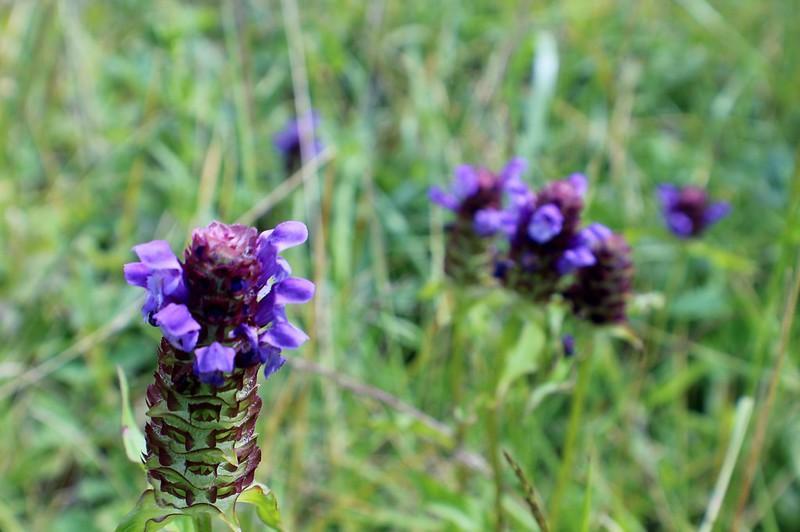
Heal-all gets its name from its diverse medicinal uses.
Heal-all is another weed on our list that belongs to the mint family. In aboriginal cultures, heal-all was used to treat a range of wounds, both inside and outside the body. However, there is little scientific research to support its exceptional healing abilities today. If the conditions of a lawn or garden are damp and moist, heal-all plants can grow very aggressively, becoming noxious weeds that are hard to get rid of. Thankfully, the weed responds well to uprooting by hand and can be easily managed.
Heal-all Quick Facts
| Scientific name | Prunella vulgaris |
| Other names | heart-of-the-earth, carpenter’s herb, blue curls, brownwort, self-heal |
| Weed type | Perennial |
| Height | Up to 2 feet |
| Flowering & leaves | – Mostly from June to August – Flowers form club-like, whirled-cluster – Leaves are serrated, lance-shaped, and reddish at the tips |
| Habitat and Distribution | – Found in open woodlands, waste areas, roadsides, and meadows |
Frequently Asked Questions (FAQs)
What are weeds with purple flowers called?
There are many types of weeds that have purple flowers. You will have to identify the weed in question in order to learn what it is called. You can use the guide above to learn about the features and characteristics of the most common weeds with purple flowers.
How to get rid of little purple flower weeds?
It will depend on the type of weed that you are dealing with. For some weeds, simple uprooting by hand is sufficient to prevent them from spreading. However, some weeds might require regular lawn mowing to eradicate them. Then, there are some weeds having purple flowers that are a nightmare. These pesky weeds may require the use of herbicides for eradication.
Are little purple flowers weeds?
All plants with purple flowers that might appear in your garden will not be weeds. Some purple-flowered plants attract beneficial insects and might be worth keeping around. So, it is better to identify and learn about the plants with purple flowers that appear in your garden before you go ahead and uproot them from the ground.
Sources for Further Reading
- What’s that purple weed? | Integrated Crop Management. (2022). Retrieved 7 April 2022, from https://crops.extension.iastate.edu/blog/rebecca-vittetoe/whats-purple-weed
- Purple deadnettle and henbit: Two common garden spring weeds. (2016). Retrieved 7 April 2022, from https://www.canr.msu.edu/news/purple_deadnettle_and_henbit_two_common_garden_spring_weeds
- Gardening Tips: Asparagus Patch Weeds and Purple Roadside Flowers. (2019). Retrieved 7 April 2022, from https://milwaukee.extension.wisc.edu/2019/06/19/gardening-tips-asparagus-patch-weeds-and-purple-roadside-flowers/
Now that you know about weeds with purple flowers, also check out our other articles:
Is Sand Good For Lawns? (and What Type of Sand for Lawns Is Best)
How to Plant Bermuda Grass | Bermuda Grass Growth Stages and Care
11 Outdoor Foliage Plants To Arrange Your Garden Like A Professional Landscape Designer







